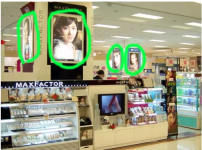Hello,
I work as a ppm at a print company in Japan and I have some questions about the color matching and management of backlit graphic posters that we produce for our clients. We do color adjustments in our prepress and do print runs in our facility when our clients sign off.
In Japan, backlit graphic posters are very common at department stores and drug stores (e.g. cosmetic brands), and many printers print whatever artwork is on translucent paper such as Yupo translucent paper using UV offset presses. Because density cannot be achieved, the way we do this is to print the artwork front and back of the paper to gain enough density so that the artwork can be seen fairly OK when it is illuminated on viewing boxes. Obviously, the image printed on the back needs to be reversed, and the registration needs to be perfectly aligned, front and back. Printing backlit posters using inkjet printers has been also common for smaller print runs.
My questions are as follows:
1) Is this method common in your countries? (printing front and back for backlit posters on offset press) . I see so much information about printing backlit graphic signs using inkjet printers but not offset press.
2) How do you manage color proofing before having been signed off for the production run? It is always difficult for us to match the colors between the color target proofs provided by designers and the proofs we make on our press during the color proofing procedure. The way we do our color proofing is to gather at our client's color viewing room and compare the colors between the color target proof (reflected light) and the backlit proofs (transmitted light). Everyone (clients and designers) seems to perceive the colors differently, and it gives us a hard time meeting their expectations.
3) Is there any practical way to manage the colors between inkjet printers and the offset press when we handle exactly the same artwork?
I know there are many variables, and the situation is quite complicated, but if you give us some advice I would really appreciate it.
Thanks for your time.
Just for reference, I attached an image of the type of backlit posters that I am talking about although these are not what we produce.
I work as a ppm at a print company in Japan and I have some questions about the color matching and management of backlit graphic posters that we produce for our clients. We do color adjustments in our prepress and do print runs in our facility when our clients sign off.
In Japan, backlit graphic posters are very common at department stores and drug stores (e.g. cosmetic brands), and many printers print whatever artwork is on translucent paper such as Yupo translucent paper using UV offset presses. Because density cannot be achieved, the way we do this is to print the artwork front and back of the paper to gain enough density so that the artwork can be seen fairly OK when it is illuminated on viewing boxes. Obviously, the image printed on the back needs to be reversed, and the registration needs to be perfectly aligned, front and back. Printing backlit posters using inkjet printers has been also common for smaller print runs.
My questions are as follows:
1) Is this method common in your countries? (printing front and back for backlit posters on offset press) . I see so much information about printing backlit graphic signs using inkjet printers but not offset press.
2) How do you manage color proofing before having been signed off for the production run? It is always difficult for us to match the colors between the color target proofs provided by designers and the proofs we make on our press during the color proofing procedure. The way we do our color proofing is to gather at our client's color viewing room and compare the colors between the color target proof (reflected light) and the backlit proofs (transmitted light). Everyone (clients and designers) seems to perceive the colors differently, and it gives us a hard time meeting their expectations.
3) Is there any practical way to manage the colors between inkjet printers and the offset press when we handle exactly the same artwork?
I know there are many variables, and the situation is quite complicated, but if you give us some advice I would really appreciate it.
Thanks for your time.
Just for reference, I attached an image of the type of backlit posters that I am talking about although these are not what we produce.












